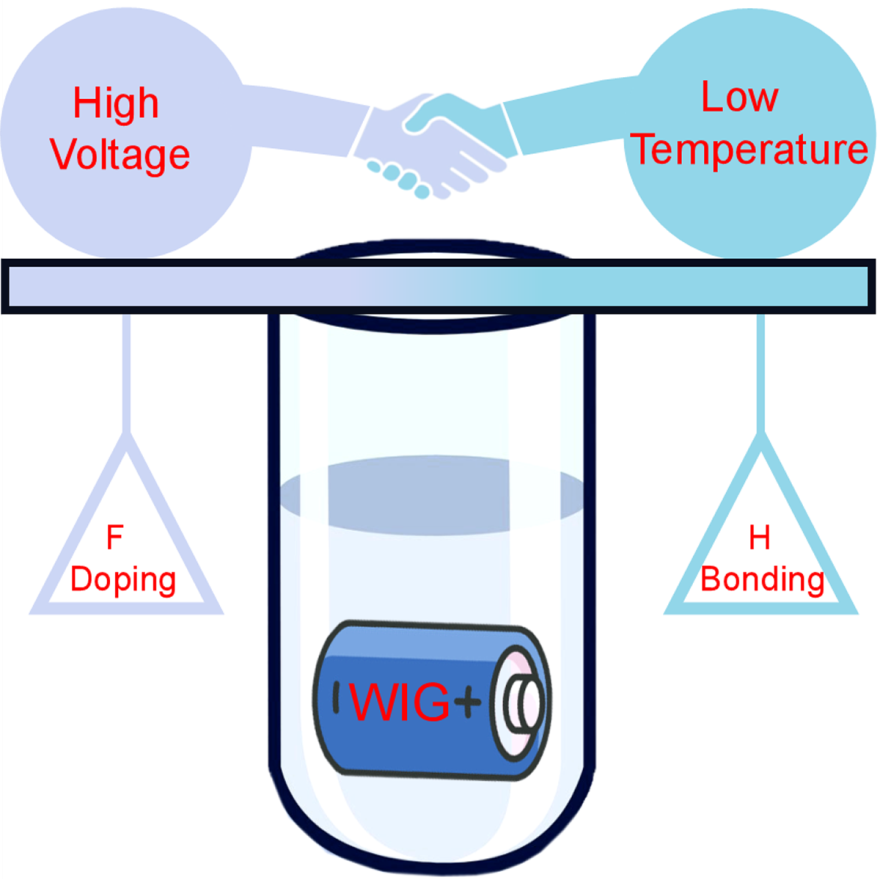Researchers from the Chinese Academy of Sciences’ Shanghai Institute of Ceramics proposed a new “water-in-ionogel” aqueous polymeric electrolyte for a low-temperature operation that allows for a relatively high operational cell voltage with high H2O content and low salt concentration.
 Image of the “F doping” and “H-bonding” design of “water-in-ionogel” electrolyte for low-temperature and in-water operation. Image Credit: Shanghai Institute of Ceramics, Chinese Academy of Sciences.
Image of the “F doping” and “H-bonding” design of “water-in-ionogel” electrolyte for low-temperature and in-water operation. Image Credit: Shanghai Institute of Ceramics, Chinese Academy of Sciences.
The findings were published in the journal Cell Reports Physical Science.
Electric vehicles and flexible electronics are entering a new phase of rapid evolution, necessitating the development of a high-energy, safe and long-lasting batteries that can withstand being bent, hit or submerged in water while maintaining electrochemical performance.
Due to their inherent safety, low cost and nontoxicity, aqueous rechargeable sodium-ion batteries with non-flammable aqueous electrolytes are attracting a lot of interest in energy storage systems.
Conventional “water-in-salt” electrolytes with highly concentrated fluorinated salts and molecular-crowding aqueous electrolytes via confining water molecules in a crowding poly(ethylene glycol) (PEG) network have poor low-temperature performance due to salting out at a high freezing point, low temperatures and sluggish charge transport kinetics of the electrolyte-electrode interphase layer.
In the current research, the water present in copolymerized PEG derived poly(ethylene glycol)methyl ether methacrylate (PEGMA) and bisphenol A ethoxylate dimethacrylate (BEMA) to develop cross-linked gels, thus generating an anti-freezing solid electrolyte by changing the hydrogen bonding.
In addition, fluoroethylene carbonate, a common electrolyte additive, was added to the PEGMA–BEMA system to form O–H...F bonds, weakening the H-bond network in an aqueous solution. This reduces the freezing point and forms solid electrolyte interfaces for ion diffusion at low temperatures.
According to scientists, a polymeric aqueous sodium-ion full cell with an Mn-based cathode and a hard carbon anode could deliver high energy density.
Notably, the environmentally friendly aqueous polymeric battery could be free-sealed to create an ultrathin, light battery that can withstand harsh conditions like being bent, cut, soaked in water or set on fire.
This study was the first attempt to create a high-voltage aqueous electrolyte for low-temperature operation.
The scientists intend to work on improving the voltage window and transport characteristics of water-in-ionogel electrolytes in the future to achieve affordable, long-term energy storage that works in sub-zero temperatures or in water.
Journal Reference:
Rong, J.-Z., et al. (2022) A free-sealed high-voltage aqueous polymeric sodium battery enabling operation at −25 °C. Cell Reports Physical Science. doi.org/10.1016/j.xcrp.2022.100805.